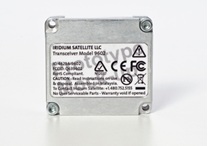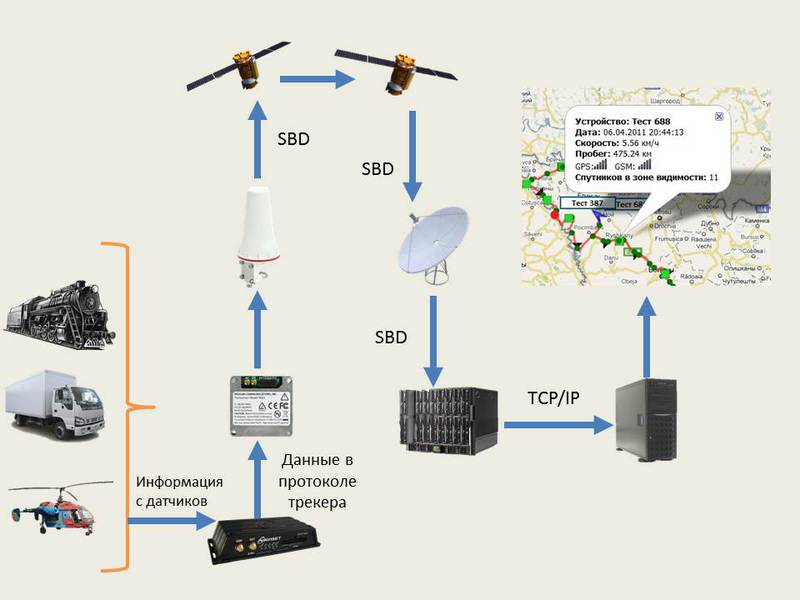Satellite monitoring. Part 1
Old tricks in a new way
Satellite monitoring of mobile objects is absolutely not new. For many years, carriers and fleets have used GPS trackers to determine the location of each fleet vehicle. It is not difficult to find out not only the location of the vehicle, but also the amount of fuel, consumption, speed and any other information from the vehicle sensors.
Until now, satellite monitoring implied location-based devices through global positioning systems (GPS, GLONASS, Galileo, etc.) and data transmission via GPRS, less often by radio or Wi-Fi.
The main problem of existing systems is the lack of global network coverage. Many companies have found a way to use the “black box”, a buffer in which information about points is stored and transmitted as soon as the network appears. But what if you need to constantly receive data? And if the technology for many months is not included in the GSM network? In our practice, there was a client who once a fortnight visited a special person with a laptop and collected data from the trackers via Wi-Fi. The decision is more than controversial.
Satellite networks and M2M
The solution to the problem was found on the surface. More precisely above the surface. From 740 to 35 000 km above the ground. Installation of trackers with satellite channel or satellite modems in support of existing systems. At the moment, two networks provide excellent coverage and support M2M services.
')
Iridium is the largest satellite network with 100% Earth coverage. 66 active satellites and 6 backup provide data transmission from the most remote corners of the planet. The height of the satellite is 740 km. At any time, at least 3 satellites are above you, which allows your equipment to spend less time searching for a beam.
Inmarsat is the second largest satellite network. Coverage is 98% and is provided by 11 geostationary satellites. However, data transmission requires pointing to the satellite or, in the case of an omnidirectional antenna, direct satellite visibility, that is, to the South.
The picture would not be complete if I did not mention the operator Thuraya, the youngest of all. The satellites of the operator are also geostationary. The coverage is significantly inferior to the previous two, but the price of traffic is captivating, both voice and IP. In addition, the company has released an all-in-one module that allows you to create your own devices. In addition, the module is strongly bribed by a low price.
In the first part we will consider the equipment for data transmission in the Iridium network.
Equipment
Iridium has a very controversial past. On the one hand, the largest satellite network, on the other hand, the bankruptcy experienced in 1999 resulted in the shutdown of all network devices. However, in 2001 the company was launched again. Guide greatly revised pricing policy. Now the transfer of data and voice costs acceptable money (a minute of conversation before 1999 is $ 5 / min, currently up to $ 1.2 / min). Satellite phone costs a little more than $ 1000, which is quite acceptable in our time.
However, not about the phones will be discussed. Embedded modules have appeared in the company's lineup, which can be used both for integration into existing devices and for creating your own data transmission devices.
Modules are of two types: SBD module and module with support for all services of the company.
The most interesting for us is the first type, and specifically the Iridium 9602 module manufactured by Nal Research.

Module 9602 is used only for the transmission of SBD traffic, which has a beneficial effect on its cost (up to $ 300).
SBD (Short Bust Data) is a type of traffic used to transmit short messages. The length of a message can be up to 1920 bytes, but more often messages are used up to 340 bytes. Data can be transmitted to e-mail, IP, IMEI of another SBD device.
The module contains: an Iridium antenna input, a GPS antenna input (assignment is not very clear. We do not use it in our device), 20 pin connector.

The RS-232 port is used to transfer information to the module.
Principle of data transmission
In the monitoring system of transport, the main transmitter is a GSM module, and the reservation occurs through the Iridium 9602 module. The route of the data packet transmitted via GPRS is extremely simple. The tracker collects data about a point (coordinates, speed, fuel quantity, etc.), compresses them according to its protocol and sends it to the monitoring server IP. However, the data compression protocol for the cellular network does not suit the satellite channel. The fact is that through GPRS messages about points are transmitted with high frequency. About twice a minute. For a satellite, such traffic consumption is an unacceptable luxury. In this regard, a special protocol has been developed that collects data from several points, packs it in one message and sends it to the server as soon as the packet size reaches 340 bytes. As a result, we have two different data formats from one device. But not all monitoring system developers are ready to implement support for additional protocols in their software. We come to the aid of solutions for emulation packages. Below is clearly shown the route of the data packet from the device to the monitoring server.

The tracker controller polls the sensors at regular intervals and collects information into a packet. Each survey period is a point and is signed by geodata. As soon as the packet volume reaches 340 bytes, the controller, via the RS-232 port, sends data to the module, from where they leave in the SBD format. Since, at the moment, the interface point (teleport) is only one, the data is transmitted from the satellite to the satellite to the teleport, where the packet is assigned an IP address and a destination port. In order for the server to know where to send the data, when registering an IMEI device, you must specify the IP address and port of our emulation server. The system can set up to 5 different points of destination. They can include e-mail, IP, or IMEI of another SBD device (this may be necessary to implement a messaging system). After the emulation server has received the data, it unpacks the packet and packages each point separately by emulating the protocol in which the data is sent via GPRS. Further information about the points is sent to the monitoring system and we can see the route passed and the state of transport at different stages of movement.
Why do you need it
It is nice to have data on the movement of vehicles, but not all companies see them as beneficial. And really, why send data via satellite, if you can collect and send it as soon as the GSM network appears?
The most compelling reason is the ability to receive emergency data. A wheel may burst, fuel will drain, engine failure and many unpredictable situations. In this case, an extraordinary package is formed and sent to the monitoring system, due to which emergency measures can be taken. In case of emergency situations not directly related to transport, you can provide an emergency call button.
Other applications
Using the example of transport monitoring, it can be understood that module 9602 can be useful in any area where it is necessary to obtain up-to-date information from remote sites or to provide a backup data transmission channel. Vending machines, rescue buoys, meters and much more equipment that requires constant monitoring. Low power mode allows you to create a modem based on the module for data transmission from points where there is no constant power. The simplest example is seismic activity monitoring sensors.
Total
Module 9602, like the Iridium operator, is far from the only solutions for M2M. Under the solution of each problem, you can pick up the necessary equipment and select the most suitable operator. In the following articles, I will describe the Iridium 9522b modem and the 9523 module, as well as talk about solutions based on the Inmarsat operator, which has long maintained a monopoly on satellite data transmission in the C and L bands in the Russian Federation. Thuraya, which also recently received a license to work in Russia, will not be ignored.
Source: https://habr.com/ru/post/148759/
All Articles